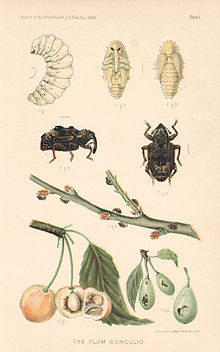- Plum curculio
-
Plum curculio 
Scientific classification Kingdom: Animalia Phylum: Arthropoda Class: Insecta Order: Coleoptera Family: Curculionidae Genus: Conotrachelus Species: C. nenuphar Binomial name Conotrachelus nenuphar
(Herbst, 1797)The plum curculio (Conotrachelus nenuphar) is a true weevil native to the regions east of the Rocky Mountains in the United States and Canada. It is notorious for destroying fruits if left uncontrolled.
Contents
Life stages
A female curculio uses a number of hosts to lay her eggs, including plums, peaches, apples, pears, and other stone fruits. After the female has chosen a suitable host, she will build an egg chamber under the fruit skin to receive the egg. She then turns around and places the egg in the cavity. Next, she slices a curved slit underneath the egg cavity to leave the egg in a flap of flesh. Eggs that do not hatch are killed from the pressure presented by the growth of the host fruit, resulting in crescent-shaped scars visible on the outside of the fruit.
Appearance
Plum curculio larva are typically 6 to 9 mm long when fully grown. After such, the beetle reaches the pupal stage measuring about 5 to 7 mm, all adult characteristics are visible in this stage prior to transformation. Adult plum curculio are about 4 to 6 mm and have a small, rough, snout colored with black, gray, and brown specks. Four pairs of ridges cover the wings; however, because of the middle humps it only appears to have two ridges.
Hosts
The plum curculio can be found in apple, nectarine, plum, cherry, peach, apricot, pear and quince. It may also survive on wild plum, hawthorn, and crabapple. It is found most commonly in areas east of the Rocky Mountains and in eastern Canada. The beetles are most active during the spring time when the weather is warm, damp, and cloudy. They are often seen in heavy leafed trees.
Injury or damage to fruit
Plum curculio beetles can cause irreparable damage to a fruit harvest. In badly damaged fruit, one can identify large scars and bumps due to feeding. Most fruit internally damaged through burrowing into the fruit often drop prematurely.
Control
Pest control of the plum curculio is fairly easy to maintain. Application of proper insecticide during the pink and petal-fall stages of apples, also the petal-fall and shuck-split stages in peaches and cherries is usually enough to reduce plum curculio damage to a minimum. A recommended preventative measure is destroying the fallen, damaged host fruits before the adults emerge.
External links
Categories:- Curculionidae
- Beetles of North America
- Agricultural pest insects
- Animals described in 1797
- Agriculture stubs
Wikimedia Foundation. 2010.

